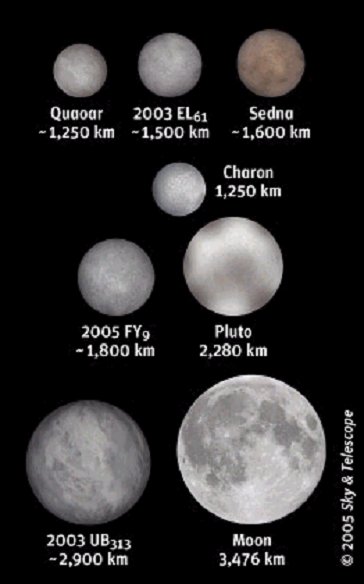
Neptun is not the most distant body of the Solar System. The Kuiper belt, predicted in 1951 and remained theory until the 1992 detection of a 150-mile wide body, called 1992QB1 at the distance of the suspected belt. There are more than 800 known trans-Neptunian (or Kuiper Belt Objects, KBOs). It is surprising that one-third of the population are engaged into the 3:2 resonance with the Neptune. Because the same resonance is also occupied by Pluto the object are named "Plutinos" (little Plutos). Probably, the resonance stabilizes the Plutinos against gravitational perturbations by Neptune. Quaoar is a newly discovered KBO, found in June 2002. The existence of 2003 EL61 was reported on 28 July 2005. KBO 2003 UB313, as big as or slightly bigger than Pluto was announced on July 29, 2005 as the X planet.
Sedna (2003 VB12), disclosed on 15 March 2004, as the coldest, most distant object known to orbit the Sun, is an exciting object with large perihelion distance. Possibly it is the first object in the cloud hypothesized in 1950 by Jan Oort cloud. The cloud, 50000 times more distant from Sun than the Earth, is a possible source of some (“Jupiter family”) comets. Sedna's presence may suggest that the Oort cloud is much closer than scientists believed.
© NASA http://solarsystem.nasa.gov

So what about the Cosmic Harmony?
As said by Kepler, it sounds in our minds, not in ears. And consists in carefully chosen gravitational, cosmo- logical and fine structure constants to make all this Universe turn
around.